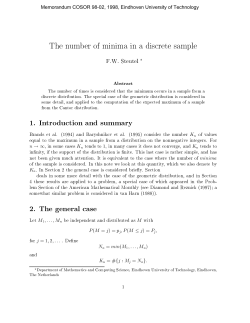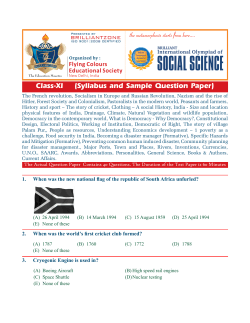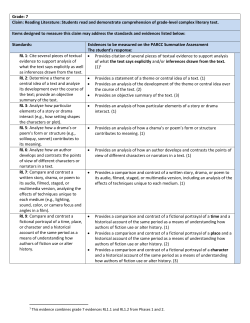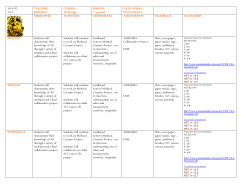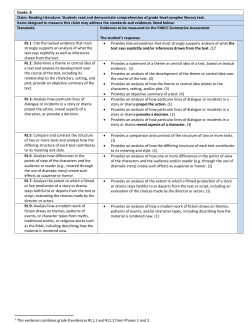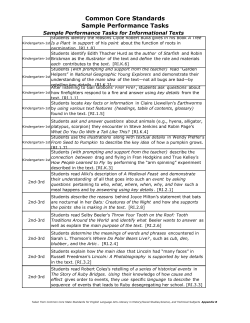
Reform in College Freshmen Programs for First Year Students
FIRST-YEAR-EXPERIENCE: REFORM IN COLLEGE FRESHMEN PROGRAMS FOR FIRST YEAR STUDENTS Brenda Marina Melisa McGuire ABSTRACT Since its inception in the 1980s, First Year Experience (FYE) programs remain an essential part of ensuring the success of freshmen, promoting retention, and further developing the strength of American higher education. Because of the stamina of the FYE reform, substantiation of this reform is apparent across the campuses of American colleges and universities. Undeniably, the reform has stood the test of time, and through endless efforts, continues to in uence rst-year students across the United States. Different today, however, American colleges and universities have not changed in the responsibility for providing positive experiences for students, faculty, and administrators. INTRODUCTION Describing the signi cance of education reform, renowned art and social critic John Ruskin (1907) declared, “Let us reform our schools and we shall nd little need of reform in our prisons”(essay 2, p.136). Paving the way for educators to acknowledge, Ruskin identi ed a pressing factor faced in the twenty- rst century. Throughout the history of higher education, issues of reform never cease in challenging existing missions, programs, admissions, policies, and overall academics. From the inception of American higher education, individuals hoping to further the cause and increase the potential of one the most in uential American institutions continuously explore opportunities for making American colleges and universities even better. Reform in higher education is incredibly complex. Often starting out as a simple suggestion, educators work tirelessly to implement what are perceived improvements, and an outright better way of doing things. Elaine El-Khawas (2002) wrote, “Most reforms do not emerge from mandates by government but instead are shaped form the ideas that emerge from the ideas that certain individuals or campuses develop” (p. 5). Surprisingly, the issues begin at the campus level through the in uence of individual interest and campus wide concern. Support comes from a variance of sources from both inside the higher education system and voluntary associations outside of the individual college or university. Consequently, reform helps de ne the purpose of higher education. The demand of addressing issues rivals the potential of stagnant, non-productive tendencies. Undeniably, the numbers of reforms in American higher education are countless. Described in three different phases, reforms are often misunderstood and overlooked as a means of implementing change (El-Khawas, 2002). The rst phase of educational reform is the initiation phase. The ideas are tossed around; success potential becomes evident. Next is the implementation phase in which the characteristics of a reform issue become a part of the program. The nal and often breaking point of determining the success of a reform issue is the institutional phase. Often measured in “enclaves” (El-Khawas, 2002, p. 2), survival of reform is only on indicator of the overall success of the issue. Other measures are evident through the acceptance of the particular issue from other institutions and the creation of professional networks (El-Khawas, 2002). As mentioned, the test of time is often an indicator of a reform’s success. The birth of a discussion on reform never ensures victory. One issue proving its worth is the First-Year-Experience (FYE) reform. Since its inception in the 1980s, the need to address college freshmen programs and improve the students’ experiences remains a focus throughout American colleges and universities. As a result of a riot on the campus of the University of South Carolina in 1970, protesting the invasion of Cambodia and other local issues, the university’s president, Tom Jay, determined the need for teaching students to love their schools and provide a positive rst year experience (Gardner, 2006). Different today, however, American colleges and universities have not changed in the responsibility for providing positive experiences for students, faculty, and administrators. With the number of students attending colleges increasing, FirstYear-Experience programs remain an essential part of ensuring the success of freshmen, promoting retention, and further developing the strength of American higher education. During the end of August and the early part of September, recently graduated high school seniors 19 Vol. 17, No. 3 embarked on the next phase of their academic career. Whether attending a family alma mater, a specialized college or university with a particular major in mind, or a local community college, freshmen come with the same goals and aspirations. For most, the academic and social structures are unfamiliar and the routine is dif cult to manage. The rst few weeks of the foreign program can determine the outcome of student’s ful llment of goals. Kirk Kidwell (2006) wrote, “Most will survive the rst-year at college and go on to graduate, but all too many drop out before the freshmen year is over” (p. 253). On the contrary, factors in uencing the decisions are numerous. Though not new, college students have faced these challenges from the inception of American higher education. Evident is the aspects that rarely are rst-year college students prepared for the demands of the freshmen year. Primarily, those that remain develop similar patterns that result in what Kidwell referred to as the “purgatorial zone” of the rst year of college (p. 253). In the initial few weeks, the goals and hopes seem achievable, and students settle in the obvious differences. Managing class schedules, getting from one end of campus to the other in fteen minutes, and nding a seat in a class of fty or more students does not seem as frightening. All of the challenges that were frustrating in the beginning seem under control. Suddenly, academics are an emphasis. Thinking that all of the strategies that were successful in high school will help with survival, the students realize most are archaic and inapplicable. Evaluation of students’ understanding of the reading for one class and the labs for another class come in the form of an exam, essay, or presentation. Frequently, the evaluations occur in the same week if not on the same day. At a point of insanity, the aspiring, young freshmen have just entered the purgatorial zone of the rst year. As Kidwell pointed out, one of the most dif cult aspects rst-year students must manage are the course requirements for each class. Unlike high school instructors, professors do not consult with one another when determining schedules for assignments. Therefore, affording empathy to students failing to meet deadlines or perform poorly on an exam due to other obligations, unlikely yields rewards. At the end of the rst wave of assignments, freshmen generally are unaware that another wave is in store. The process seems endless. Lack of neither intelligence nor aptitude has any bearing on the students’ success. Slowly, the transformation begins, and students realize the importance of adapting to an entirely different pattern that is necessary for college achievement. Old habits die-hard and new methods of studying, planning, preparing, and thinking emerge by end of the rst year. Hopefully, students begin thinking critically and taking responsibility for their learning (Kidwell, p. 254). Though dif cult lessons for students to learn, the element of purgatory is most challenging for anyone, especially the freshmen students entering their rst year of college, Kidwell indicates, “Students may appear cynical or jaded but actually begin playing the game to earn the best grade” (p. 254). These skills carry on, and the survival of the rst year is proof enough that the student can continue. Though students succeed while others fail, ignoring these patterns is detrimental to higher education. Obviously, there is a horri c breakdown in the freshman year of college. First, the pro le of the average college freshman is continuously changing. A variance in gender, socioeconomic class, race, religious af liations, sexual preferences, and overall background make up the faces on American college campuses. Students enter their rst year with a variety of experiences contributing to their success. Some have strengths while weaknesses inhibit others. The breakdown begins with failure to meet these needs. Fortunately, educators recognize this, and through reform, the rst year experience, the purgatorial zone, is becoming manageable. One educator that felt the need to change rst year experiences for students entering college is John Gardner. In 1967, John Gardner arrived in South Carolina serving as a psychiatric social worker for the United States Air Force. (Policy Center of the First Year of College). In 1970, Gardner embarked on a lifelong academic career as fulltime faculty member, teaching courses in history, communications, higher education, and a variety of special topics. Along with distinguished awards in his efforts in education, Gardener is best know for initiating the reform movement in 1982, bringing attention to improving the freshmen year (Policy Center for the First Year of College). Coined by Gardner as the First-Year-Experience, (FYE), the concept enhances “the learning, success, retention, and graduation of students in transition, especially rst year students. . .” (Policy Center for the First Year of College). Educational Planning 20 Through endless efforts, John Gardner implemented, initiated, and institutionalized reform practiced throughout American college campuses. In 1986, Gardner founded The National Resource Center and later in 1995, renamed the organization, The National Resource Center for The First-Year-Experience and Students in Transition. Recruited by former University of South Carolina President, Tom Jay, John Gardener welcomed the opportunity to explore ways of discouraging future riots, disruptions, and overall disenchantment as expressed by students participating in the riot in May of 1970. Like many rst year students or students in transition, Gardner too experienced many disputes that could have destroyed his college career within the rst year experience in college. Never forgetting the strife, John Gardener took the necessary steps to make University 101 more, “intellectually stimulating. . .combining it somehow with professional development. . .and to somehow made it a more scholarly endeavor” (Gardner, 2006). Thus, Gardner established a master model for following and received unending approval and praise from his colleagues and other constituents. Across the campuses of American colleges and universities, evidence of his tireless efforts is apparent in various forms. Generally, all missions resemble the outline implemented from the inception, and it is a hope that students’ attitude about their school and their purpose for attending the school is more prideful than when the students rst began. Because of the stamina of the FYE reform, substantiation of this reform is apparent across the campuses of American colleges and universities. Undeniably, the reform stands the test of time, and through endless efforts, continues in uencing rst-year students across the United States. According to Mary Stuart Hunter and Carrie W. Linder, “First–year seminars have become a common approach adopted by higher education intuitions in their efforts to ease the transition to college for new students, and to systematically address unacceptable rates of student attrition”(p. 1). With the impeccable record of accomplishment, FYE reform proves as one of the most successful higher education movements in all of American higher education. Unique in purpose, rst year seminars “satisfy both institutional and student needs” (Hunter & Linder, 2007). The seminars are unique in purpose, instruction, and goals. Following the common idea of seminar forms, rst year seminars are small and are open in exchange of ideas between both instructors and students. Most often, the seminars fall into ve categories: basic study skill seminars, professional or discipline linked seminars, extended orientation seminars, academic seminars on various topics across sections, and academic seminars with generally uniform content across sections (Hunter & Linder, 2007). In the case that a seminar does not necessarily match up to an existing category, other elements help establish criteria. No matter the title of the seminar, all of the seminars share common objectives, in that the focus is on individual student needs. Each course shares in striving to make the rst-year experience more realistic with assistance the transition into college and the academic and social development of rst-year students. While modeling recommendations from The National Resource Center for The First-YearExperience and Students in Transition, higher education programs across the United States exempli ed good practice creating distinctive programs and replicating existing programs. The Centre for the Advancement of University Teaching (2007) suggested that the freshmen year should consist of integrated, interdisciplinary, and inquiry-based learning. The freshman year: • Marks a transition in the lives of young people both socially and academically; • Needs to bridge between high school and home and to excite the student by wealth, diversity, scale, and scope of what lies ahead; and, • Must be intellectually integrated, so that the student will not learn to think of the academic program as a set of disparate and unconnected requirements (Centre for the Advancement of University Teaching). Recommendations for the rst year included: A student should be adequately prepared to meet the intellectual challenges of that program; if remediation is necessary, it should be completed before entering that program. 1. All rst-year students should have a freshman seminar, limited in size, taught by experienced faculty and requiring extensive writing, as a normal part of their experience. 2. The freshman year must include opportunities for learning through collaborative efforts, such as joint projects and mutual critiques of oral and written work. 21 Vol. 17, No. 3 3. The freshman program should be carefully constructed in an integrated, integrated, Interdisciplinary, inquiry based experience. Overall, the plan and efforts seem quite explanatory and offer room for exploration and re nement for existing FYE programs and those that are just beginning. New program implementation often presents challenges, but with experienced professionals offering guidance, the recommendations provide a structure that leaves room for exibility in adapting to individualized additions speci c to any campus’ pro le. In an effort to encourage more colleges and universities to think about the way in which the rst year is portrayed, Robert D. Reason, Patrick T. Terenzini, and Robert J. Domingo (2006) presented research supporting the importance and impact the rst year of college has on a students overall success. As indicated, “The rst college year is critical not only for how much students learn but also for laying the foundation of which their subsequent academic success and persistence rest” (p. 150). Though not new to John Gardner and his colleagues, the study that was part of The Foundations of Excellence Project clearly supported, “The losses that many individuals and most institutions experience during a student’s rst year re ect and unacceptable and unnecessary waste of individual, institutional, and national talent and resources” (Reason, et al. p. 150). So much happens within the rst few moments that a student ascertains a relationship with a college or university. The moments are critical and if approached effectively, this waste is preventable and avoidable. Undeniably, interconnected factors of the college (Reason, et al., p. 150) “in uence academic success and persistence among rst year students” (p. 150). Identi cation of this connection surely strengthens FYE programs importance. According to the ndings of the study, seven principals, or Foundation Dimensions, were effective in promoting the success of rst year students. (p. 151) The principles were: 1. Have organizational structures and policies that provide a comprehensive, integrated, and coordinated approach to the rst year. 2. Facilitate appropriate recruitment, admissions, and student transitions through policies and practices that are intentional and aligned with institutional mission. 3. Assign the rst college year a high priority for the faculty. 4. Serve all rst-year students according to their varied needs. 5. Engage students, both in and out of the classroom, in order to develop attitudes behaviors, and skills consistent with the desired outcomes of higher education and the institution’s philosophy and mission. 6. Ensure that all rst-year students encounter diverse ideas, world views, and people as a means of enhancing their learning and preparing them to become members of pluralistic communities. 7. Conduct assessment and maintain associations with other institutions and relevant professional organizations in order to achieve ongoing rst –year improvement. (p. 151-152) From 2005-2007, there were 57 colleges and universities accepted to participate in the self-study for the Foundations of Excellence Project. Two-year and Four-year institutions, such as Spokane Falls Community College, Longview Community College, New Mexico State University, The University of Akron, and Georgia Southern University, schools from all regions across the country participated to enhance and improve rst-year initiatives. The measuring of the institution’s current level of achievement demonstrated the need for change, and the Dimensions statements were utilized for suggestive actions that a college or university might take to improve the rst year. Many task forces discovered ways they could immediately improve the rst year and initiated actions as a result of the self-study process. The University of Akron, located in the Midwest had a mission and vision for the rst-year experience similar to Georgia Southern University, located in the South. The University of Akron had taken positive steps to make a positive difference for students, the members of their Dimensions’ committees found the following areas for growth: a need for a rst-year philosophy that is disseminated across campus, the need to include more exposure to diversity modules within students’ rst-year, and General Education courses; more extensive professional development for faculty and administrators working with rst-year students; common components within rst-year course syllabi; the need for a University-wide communications audit to determine the best ways to communicate with the rst-year students; development of opportunities for students and faculty to interact outside Educational Planning 22 of class through participation in service learning, mentoring, and undergraduate research programs; a reward system for faculty with high levels of interaction with rst-year students; and the need to assess and address students’ computer literacy (The University of Akron, 2007). According to the University of Akron Foundations of Excellence Self Study Report (2007) “The faculty and administrators who served on the various Dimensions committees gained a better understanding and appreciation of the work of others on campus who assist new students” (p. 3). Georgia Southern University (GSU) submitted a Quality Enhancement Plan (QEP), as part of the University’s reaf rmation through the Southern Association of Colleges and Schools (SACS) in 2005. Three of the ve objectives of the QEP focus on the rst year: Freshmen will apply behaviors that demonstrate their responsibilities as engaged learners. Freshmen will practice behaviors that lead to lifelong learning. Freshmen will evaluate their responsibilities as engaged members in diverse communities. Through its participation in the Foundations of Excellence® project, the First Year Experience (FYE) program at Georgia Southern University is helping the larger University community achieve these objectives. This process yielded many signi cant ndings, three of which signi cantly shaped the work of the Faculty Task Force: 1. Compared with other institutions who participated in the Foundations of Excellence project, Georgia Southern scored fairly well when it came to affective measures of student engagement, but underperformed in areas of academic engagement. 2. On the whole, faculty envisioned the First-Year Experience as a Student Affairs unit rather than an Academic Affairs one. Because of this, efforts to improve FYE were not seen as an Academic Affairs responsibility. 3. Students did not, in large numbers, report that Georgia Southern accurately communicated academic expectations prior to enrollment. Only 49 percent indicated that the University did so to a “very high” or “high” degree. As a part of this process, the FYE program has revised the learning outcomes for the GSU 1210 course to embrace the objectives. Listed below are the Student Learning Outcomes: Seminar outcomes Students will be able to. . . S1. Critically evaluate print and electronic information for its currency, relevancy, authority, accuracy and purpose. S2. Apply documentation guidelines for print and electronic information used in assignments. S3. Articulate what constitutes plagiarism and avoid representing the work of others as their own. Extended orientation outcomes Students will be able to. . . EO1. Examine societal rationales for supporting college education and their own personal motivations for attending college. EO2. Locate Georgia Southern resources and services necessary for their academic and personal success. EO3. Analyze their use of time in relation to their goals and either: 1) develop a plan to align their use of time more closely with their goals; or, 2) defend their use of time as appropriate for achieving their goals. EO4. Describe and explain academic expectations in relation to their course of study. EO5. Identify different learning styles, evaluate which learning styles are most effective for their academic success, and develop personal strategies for learning that take into account their preferred learning styles. EO6. Examine common college-student choices and relate them to their academic and personal circumstances. 23 Vol. 17, No. 3 Because of these ndings, the Provost formed the Faculty Task Force and charged the group with developing challenge/support initiatives, particularly academic in nature, to strengthen the First-Year Experience on campus. The group is charged with examining students’ experiences before enrollment, during the GSU 1210 course administered during the rst semester, and beyond the rst semester. Common themes among the numerous American institutions have been reported. Project leaders from former participating universities and colleges are reporting results such as: o Enrollment gains; o Increased campus-wide awareness of the importance of the rst year; o Improved academic affairs/faculty/student affairs collaboration; o More faculty buy-in to rst-year efforts; o Connection with institutional reaf rmation of accreditation; o Creation of philosophy and mission statements for the rst year; o Creation of new rst-year structures; o Creation of permanent task forces, advisory councils, committees for oversight of the rst year; and, o Creation of new or improved rst-year programs and activities, such as improved student-to-student mentoring (fy.foundations.org). Clearly, the framework presented assists in promoting rst-year success for students. Though unambiguous, room for error still exists and not all students will necessarily bene t from every aspect of the principals or from the guidelines of The National Resource Center for The First-Year-Experience and Students in Transition. Research is ongoing and the efforts of the reform are not in vain. The desire for change and will for successful students persists. Educators agree there is room for growth in the foundations of American higher education. Careful planning along with dedicated participants supports research presented. Willingness for trial and error supports potential growth in FYE throughout American higher education. Equally important with the guidelines and implementation, exploration of individual institutions FYE programs is signi cant. In a survey of students attending Emory University, Georgia State University, Kennesaw State University, and Le Grange College, consistent responses regarding freshmen experiences prevail. For the most part, the participants indicated a positive outcome of First-YearExperience membership. Individuals agree FYE programs play a signi cant role. Though sharing similar characteristics such as grouping, topics of discussions, and required involvement, it is conclusive that each school added a particular aspect that made the program unique to the school. At Emory University, Kennesaw State University, and Georgia State University, students participated in the program for the entire semester while students at Le Grange College only devoted three days to the plan. Characteristically different names such as Cornerstone and PALS add to the distinctive nature of the programs. Shared distinctiveness among all schools mentioned included active parts of freshmen orientation, student lead seminars, creative approaches to social issues and providing peer support. Positive attributes of the First-Year Experience programs included trusting environment, individualized guidance, camaraderie, mentorship, instilling school and class pride, development or organizational skills, and understanding of the rst year. Role-playing and team building were two common areas of activities shared by the groups. All agreed that every incoming student should take the course and that it should constitute part of the core curriculum and students should receive credit hours for participation. Each concurred there were memorable experiences shared, and two of the four individuals actively remained in contact with someone from the group. Though not emphasized, negative aspects discussed during the interviews provided insightful information. All students agreed that the outside commitment of after school and weekends created stress throughout the class. The required reading, testing, and nal exam aspects generated additional pressure participants felt was unneeded. Another common complaint was disorganization among the instructors. Two students indicated that on different occasions, it was unclear, which instructor would teach the course and if they were there by choice or forced into carrying the class. Though a primary focus of First-Year Experience Reform, John Gardner emphatically stated his Educational Planning 24 intentions for establishing FYE was never about retention (Gardner, 2006) While American colleges and universities steadily progress into corporations, not all involved can ignore attrition numbers. Undeniably, long-term outcomes of FYE programs prove higher graduation rates for students that complete the programs. In re ecting on the twenty- ve years of FYE, John Gardner comments at a 2006 conference, Well, we have had many successes. The rst year is taken much more seriously today than it was 25 years ago. The notions of the “ rst-year experience” are well established in the lexicon of higher education. Now it is not only or even primarily chief student affairs of cers who are pushing the agenda for an improved focus on the rst year, but the chief academic of cers. Hundreds, actually, thousands, of campuses now have the archetypal rst-year signature interventions such as the rstyear seminar, learning communities, service learning. Supplemental instruction and campus-wide initiatives known as “the rst-year experience” focus on the needs of rst-year students and has led to the creation of a quasi rst-year profession, such that professional positions are advertised in higher education trade publications. Disciplinary and professional associations focus on rst-year courses and improvement strategies. The press covers campuses’ efforts to improve the rst-year experience. The original language, “the freshman-year experience” has become more inclusive and accurate in its reconstitution as “the rstyear experience.” And many campuses have stopped referring to their predominantly female, and overwhelmingly not “fresh” new students as “freshmen.” The original conference organization and then higher education center that promoted this increased level of attention to the rst year, has ourished and moved to successively greater levels of impact. Other higher education centers beyond University of South Carolina (USC) also have taken up this banner. Graduate courses on the study of the rst-year experience movement are beginning to nd their way into the curricula of schools of education. A legitimate new eld of scholarly research and publishing, thanks largely to USC (and Jossey-Bass Publishing Company) has developed around this larger effort to improve the rst year of college foundations, and government agencies award grants to improve the rst year. A huge for-pro t industry, or industries, have developed to cultivate, support, and sell products and services to this burgeoning eld of activity. The focus on the rst year has led to an expanded application of lessons learned to other critical transitions during the undergraduate years; in particular, what is called “the sophomore year experience” and “the senior year experience.” Thanks to The Pew Charitable Trusts, George Kuh, and the Indiana University Center for Postsecondary Education, a powerful national conversation and action steps have occurred focusing on the concept of “engagement” behaviors and practices of both students and institutions (as in the use of the National Survey on Student Engagement (NSSE) and Community College Survey on Student Engagement (CCSSE) in four-year and two-year institutions, respectively). The rst year improvement efforts are gradually being folded into the work of regional accreditors, most notably now, the Higher Learning Commission, thanks to the leadership of its Executive Director, Steve Crow, whereby any of their 1000 institutions may now accomplish reaf rmation of accreditation by doing either a special emphasis self study such as the Program to Evaluate and Advance Quality (the PEAQ option) or a special improvement project such as the AQIP-Academic Quality Improvement Program (the AQIP option) focusing on the rst year. In the Southern Association of Colleges and Schools (SACS) region, a focus on the rst year is increasingly being integrated into Quality Enhancement Plans. A set of standards for excellence in the rst college year, for purposes of both measurement of institutional performance and aspirational design, have been developed by over 300 participating two and four-year colleges and universities (www.fyfoundations.org). What began as, at best, a national set of activities has greatly expanded to a true international set of partnerships, scholarly works, convening, and movement. Though numerous, the list of accomplishments are prideful in tone and appreciative in support. Gardner too recognizes areas of growth. He indicated that in spite of all the energy, action, positive outcomes: There is abundant evidence that students are not as engaged as we would like. There is also evidence that students are not as engaged during the rst year of college as they thought they would be! 25 Vol. 17, No. 3 Levels of performance in high DWFI rate courses should be a cause for embarrassment and action, especially in mathematics. There is still too much unacceptable attrition. There is much instability in the viability and leadership rst-year “programs”; the response of the academy to the challenges of the rst year has been primarily to design “programs” rather than a more comprehensive institutional response. On some campuses these “programs” are, at best, still eating crumbs on or under the table the mantra that surrounds the rst year, as the basis for reform is not academic and not suf ciently motivational (i.e. retention) to take us to the next level. We are competing for everscarcer resources in a larger society that does not currently share our values, and we are competing for students’ most precious of resources: their time, energies, attention, priorities, discretionary monies—our rst college year endeavors vis a vis their jobs, families, pursuits of pleasures, busy demanding lives. Knowingly successful, Gardner constructively recognizes areas of growth and willingly challenges striving for bettering existing First-Year-Experience for American college campuses. Conclusions regarding First-Year-Experience indicated countless af rmative qualities. John Gardner, along with his constituents, identi ed an imperative area for reform and strived for improvement and excellence. Evidence indicated the realization of the individuals and the passion they posses for educational reform and student achievement. Educational reform, regardless of the issue, whole-heartedly begins with belief. The conviction of student success began with one person, and with the dedication of one man, the reform became a reality, offering promise for the future of American higher education and the guarantee of promising college students. Should your campus consider participating in the Foundations of Excellence Project? Over the past 25 years, the importance of the rst year of college has been acknowledged to some degree by a wide range of American colleges and universities. The result has often been the creation of an array of program-level initiatives, many of which operate on the margins of the rst year and have only limited impact on students. Such well intentioned efforts have existed in the absence of a structured model of excellence that goes beyond a single program to a broader vision of a campus’s comprehensive approach to the rst year. By conducting a systematic rst-year self study under the guidance of the Policy Center on the First Year of College, a campus can take a candid look at its strengths and weaknesses and, based upon its ndings, develop a strategic action plan that can lead to enhanced student learning and persistence. Participation can be an invigorating, institution-wide experience that brings together a multitude of constituent viewpoints about improving the campus’s rst year and can lead to substantive institutional change and improved student outcomes. The following publications may be useful to leaders and administrators interested in planning for change (Policy Center on the First Year of College): Barefoot, B. Gardner, J., Cutright, M., Morris, L., Schroeder, C., Siegel, M., Schwartz, S., & Swing, R. (2005). Achieving and Sustaining Institutional Excellence for the First Year of College. San Francisco: Jossey-Bass. Upcraft, M. L., Gardner, J., & Barefoot, B. (2004) Challenging and Supporting the First-Year Student : A Handbook for Improving the First Year of College. San Francisco: Jossey-Bass. Swing, R. (2001 & 2003). Proving and Improving: Strategies for Assessing the First College Year, Vols. 1 and 2. Columbia, SC: National Resource Center for The First-Year Experience and Students in Transition. Essays posted on FYA-List (First-Year Assessment Listserv). Foundational Dimensions® for Four-Year Colleges and Universities. Foundational Dimensions® for Two-Year Colleges. REFERENCES Centre for Advancement for University Teaching. Higher education reform in the united states. Retrieved September 21, 2007, from http://www.hku.hk/caut/new1/cr/ higher _education_us1.htm#2 Hunter, M. S., & Linder, C. College Seminars for rst–year students-types of rst-year seminars, course objectives and content, pedagogy and staf ng, instructor development. Retrieved September 21, 2007, from http://education.stateuniversity. com/pages/1862/College-Seminars-First-YearStudents.html Educational Planning 26 Gardner, J. G. (2006). The rst–year experience’s rst 25 years-the jury is in, but out on the next: you can determine your verdict. Retrieved September 25, 2007, from http://www .sc.edu/fye/events/ presentation/FYEAnnualConf06PlenarySpeech.pdf Georgia Southern University. (2006). First year experience: Quality enhancement plan. Retrieved March 14, 2008 from http://academics.georgiasouthern.edu/fye/QEP.htm Kidwell, K. S. (2005) Understanding the college rst-year experience. Clearing House: A Journal of Educational Strategies, Issues, and Ideas, 78(6), 253. El-Khawas, E. (2002). Reform initiatives in higher education: an encyclopedia (Report No. RR-93-000036). Washington, DC: ERIC Clearinghouse on Higher Education. (ERIC Document Reproduction Service No. ED470037) Policy Center on the First Year of College. Retrieved September 21, 2007, from http://www. rstyear. org/staff/john.html Reason, R. D., Terenzini, P. T., & Domingo R. J. (2006) First things rst: developing academic competence in the rst year of college. Research in Higher Education, 47(2), 149-175. Ruskin, J. (1907). Unto this last: And other essays on art and the political economy. Essay 2, p. 136. New York: E. P. Dutton. The University of Akron (2007), A Self Study Report 2006, Foundations of Excellence. Retrieved March 14, 2008 from http://www.uakron.edu/colleges/univcoll/docs/FYE-SelfStudy Report2006.pdf 27 Vol. 17, No. 3
© Copyright 2025
